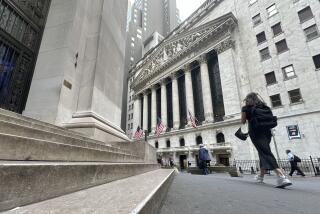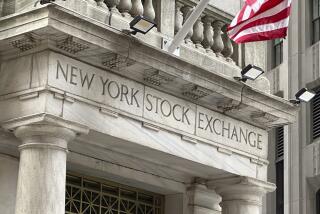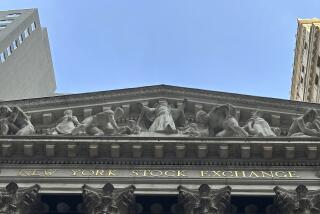Shelter From the Storm
No storm lasts forever. But how many second winds will there be for the tempest that has been battering the stock market since March 2000?
Major share indexes tumbled in the second quarter, leaving the market with its worst decline for any calendar first half since 1970.
The blue-chip Standard & Poor’s 500 index dropped 13.4% in the quarter and 13.2% in the half, including dividend income. The technology-heavy Nasdaq composite sank 20.6% in the quarter and 24.8% in the half.
What has ailed the stock market this year are, to a large degree, more of the same issues that have dominated since shortly after the new millennium dawned: worries about the outlook for economic and corporate profit growth; fear that the world has become a much more dangerous, and therefore risky, place; and the sense that stock valuations simply became too giddy in the late 1990s and haven’t yet sobered up enough.
The market hardly needed another dark cloud to arrive, but one did anyway: the torrent of corporate accounting scandals, further dashing investors’ faith in stocks.
With the losses this year, key share indexes are in danger of declining for three straight calendar years. That hasn’t happened since the war years of 1939-41.
By one measure, the average domestic stock mutual fund already is in the red for the three years ended June 28. Fund tracker Morningstar Inc. calculates the average annual return on the typical domestic fund at negative 4.3% for the three years.
That marks the first time since 1975 that the three-year average return has been negative. All in all, then, investors would have been better off keeping their money in a bank savings account than in a stock fund since mid-1999.
But without papering over the severe losses wrought by this bear market, investors would be wise to keep perspective, financial advisors say: Many stocks, and stock funds, have fared far better than the S&P; and Nasdaq indexes this year and over the last three years.
Though technology stocks seem to have become a black hole, shares of smaller companies, “value”-oriented shares such as real estate investment trusts and even many foreign stocks have offered relative safety this year.
For example, the average small-stock value fund was up 4.5% in the first half and has risen at an annualized rate of 11.8% in the last three years, according to Morningstar.
The average real estate fund rose 13.3% in the first half and has gained 12.6% a year over the last three years.
The problem is that too few investors diversified into those sectors in the late 1990s. Rather, their portfolios were, and perhaps still are, overloaded with big-name “growth” stocks and technology.
What’s more, many growth-fund managers themselves have remained heavily invested in tech stocks, betting that the bottom had been reached. “Recent returns show that the [growth] group is still shackled to technology’s misfortunes,” fund tracker Lipper Inc. said in its midyear report.
But the market malaise in the second quarter gripped more than just beaten-down tech issues. Doubts about the truthfulness of corporate accounting added to selling pressure in many non-tech blue-chip issues. Home Depot Inc. slid 24% in price, for instance. Johnson & Johnson lost nearly 20%, General Electric Co. sank 22% and Citigroup Inc. fell 22%.
The equity market’s continuing losses may be causing more investors to ask that most basic question: Should they even be in the stock market?
Older investors, or those saving for a goal such as college tuition, may have a temptation to give up--or at least lighten up--on stocks.
It’s never too late, or too early, to make changes that improve your portfolio diversification, financial advisors say. Still, they warn that dumping stocks wholesale at this point might well mean selling low.
“Market timing is a dangerous and difficult thing to do. But if you are going to try to time the market, the question is whether now is the right time to get out,” said Scott Leonard, a financial planner in Manhattan Beach.
“We may be nearing the end of the downturn,” he said, noting that the duration of this bear market makes it one of the longest in modern history.
Tom McKissick, co-manager of the TCW Galileo Large Cap Value fund in Los Angeles, expressed a similar view. “Not so long ago the definition of risk was, ‘I don’t want to be left behind. It’s a new era and I want to be in the [market] game.’ It used to be scary to be out of the market, and now it’s kind of scary to be in it,” he said.
“But the last extreme was proven wrong, and I don’t think this extreme will go on forever either. I think we’re closer to the eighth inning of all this, rather than the second,” McKissick said.
To be sure, most advisors say money that might be needed within a few years should never be in stocks in the first place.
Also, many investors have learned the hard way that their portfolios needed a buffer against stock losses. Bonds, bank CDs and other income-generating investments have gained a new appreciation with many Americans.
“People should reassess their portfolios and consider rebalancing,” Leonard said. “If you’re truly diversified you should not be down more than 5% [in your overall portfolio] in the last two years.”
Even when the bear market has breathed its last, the question is what kind of market will follow. A new, rip-roaring bull? A market that trades sideways for years? A classic stock-picker’s market in which there will be as many stock losers as winners?
One thing seems certain: Barring economic meltdown, some companies and industries will fare well in this decade. Investors who can identify them have a better chance of making money on Wall Street.
In the first half of this year, many stock sectors posted double-digit gains despite the double-digit losses in broad market indexes.
Within the S&P; 500, strong stock groups this year have included metals and mining, housewares, managed health care, aerospace and home builders.
Within the S&P; 600 small-stock index, the leading groups have included home improvement retailers, commodity chemical companies, recreational vehicle makers and footwear makers.
Whether those sectors can continue to lead is anyone’s guess. But as investors review the performance of their stock mutual funds this year, a key question to ask is whether your fund managers are invested in sectors and individual stocks that you believe could be poised for growth.
If your fund manager still is focused on tech, and you don’t believe tech will lead any market rebound, you could be in the wrong fund.
“People should always look at their overall portfolios and their specific fund managers to make sure they are on the same page,” said John Snider, who co-manages TCW Galileo Large Cap Value with McKissick. “You don’t need periods of extreme volatility to ask whether you have a manager with the same philosophy of investing.”
Whitney George, manager of the Royce Low-Priced Stock and Royce Micro-Cap funds in New York, has been in the market’s sweet spot in recent years: small-cap value. He thinks the category may retain its edge, but by a thinning margin.
“Going forward I’d expect things like the ... fund category to be less important than they have been,” George said. “It’s going to be a stock-picker’s market, a muddled picture in an era of modest returns.”
George’s bottom-up approach to investing has led him to areas more traditionally favored by growth investors. His funds currently have weightings of 15% to 20% in tech and 10% to 15% in health care, both of which are higher than normal, he said, as the drubbing in tech and biotech stocks has created buying opportunities.
At the same time, George has shied away from some traditional value sectors such as banks and home builders that have done well over the last year, lifting the valuations of those shares.
By contrast, George believes that the red-hot gold-mining sector might have steam left.
“Gold may be coming out of a 20-year bear market. A lot of mining company executives are certainly hoping that this move from $260 to $310 [an ounce] isn’t all there is,” George said.
He said the mining industry can continue to benefit from the “dramatic consolidation” of recent years, and that strong performance could beget continuing strong performance as more investors look to diversify their equity bets.
With gold, “many people are rediscovering an asset class that had been written off, just as small-cap value was in 1998,” George said. “They called us a dinosaur, and the same thing happened with gold. But people are going to be looking at their mutual fund tables over the next couple of weeks, and gold is bound to attract attention--and money--from investors.”
As for smaller stocks, Sam Stovall, strategist at Standard & Poor’s Corp. in New York, said small-cap leadership cycles tend to last three to five years. So if history is a guide, this one could have another six months or more to run, he said.
Typically, Stovall said, a cycle of small-cap leadership peaks with the price-to-earnings ratio of the small-cap S&P; 600 index at a 30% premium to the big-cap S&P; 500’s P/E. Recently, small-cap valuations pulled about even with large-caps, with both sectors priced at 18 to 20 times estimated operating earnings per share over the next 12 months.
Will Muggia, co-manager of the Touchstone Emerging Growth fund, said he likes the longer-term prospects for energy and biotechnology.
The U.S. economic recovery is likely to drive demand for energy, particularly in the natural gas segment, Muggia said.
And with many biotech shares down more than 40% year to date, “a lot of those stocks have gotten too cheap to ignore,” Muggia said. But in the risky and volatile biotech sector, it’s important to focus on companies with clean balance sheets and products in late development or headed to market, he added.
Muggia and McKissick said that, unlike George, they have largely steered clear of tech and telecom, noting that capital spending remains depressed.
McKissick said he and Snider still prefer old-line sectors such as railroads and industrial gas producers, along with a smattering of “broken growth stocks” such as retailers Gap and Toys R Us.
“These are companies where we’re anticipating a turnaround after a period of mismanagement,” McKissick said. “We could be wrong, of course, but the stocks are priced at low enough multiples so that the downside is probably limited.”
More to Read
Inside the business of entertainment
The Wide Shot brings you news, analysis and insights on everything from streaming wars to production — and what it all means for the future.
You may occasionally receive promotional content from the Los Angeles Times.










